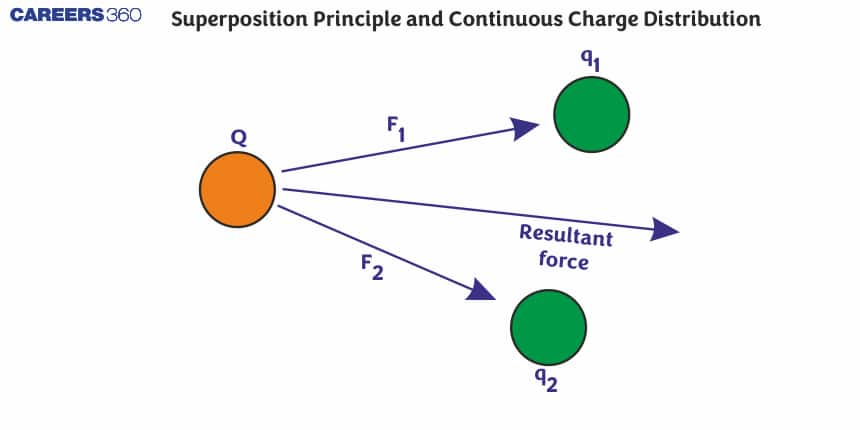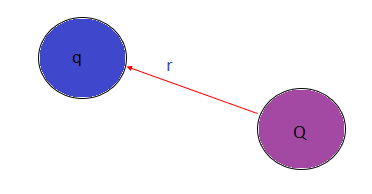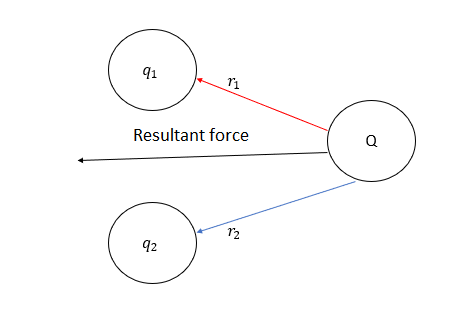Superposition Principle and Continuous Charge Distribution - Detailed Guide
In this article, we will learn about the law of superposition which is also known as the principle of superposition.
Note: Superposition theorem in hindi is अध्यारोपण प्रमेय

What is superposition?/superposition meaning:
Overlapping one thing over the other is called the superposition.
Also read -
What is principle of superposition?/superposition principle in electrostatics/define principle of superposition
The principle of superposition states that the total force on a charge due to a number of other charges is given by the vector sum of the Coulomb forces exerted on the charge due to each of the other charges acting separately. This law is also known as the principle of superposition of forces.
Let us consider , there are N no of point charges like q1,q2,q3,q4,…….,qN.The total force acting on charge q for N no of charges is the sum of the individual forces F1,F2,F3,F4…..FN .So, the total force on the charge q is
F=F1+F2+F3+F4+…+FN=i=1NFi
The superposition principle is used in the calculation field, flux, potential energy of an electrostatic system.
Let us consider an example,
According to Coulomb’s law, the force between two charges be,

F=14π0.Q.qr2.r
Here,
F = total force
Q = test charge
q = point charge
r = distance between two charges
The principle of superposition can be shown with a minimum of three charges, but this principle is used for a large number of charges or N number of charges. In the below example, we will discuss the superposition principle

According to the diagram,
F1=14π0Q.q1r12r1
F2=14π0Q.q2r22r2
According to the principle of superposition
FQ=14π0[Q.q1r12+Q.q2r22]r
Here , Q = test charge ; q1=q2= point charge; r1= distance between the test charge and q1 charge ; r2= distance between the test charge and q2 charge ;r = the direction of the resultant force ; FQ= resultant force .
Related Topics Link, |
Continuous charge distribution:
As we know, charge carried by a body is always an integral multiple of the smallest unit of charge which is a charge of an electron. According to this theory of quantisation of charge, it can be said that an electron has the smallest charge.
When the charges are very closely bound to each other then that type of charge distribution is known as continuous charge distribution.
According to the principle of superposition of charges, here are three types of continuous charge
- linear charge distribution
- Surface charge distribution
- Volume charge distribution
Also Read:
- NCERT solutions for Class 12 Physics Chapter 1 Electric Charges and Fields
- NCERT Exemplar Class 12 Physics Solutions Chapter 1 Electric Charges and Fields
- NCERT notes Class 12 Physics Chapter 1 Electric Charges and Fields
1. Linear charge distribution:
When the charges are distributed uniformly in one dimension or along length then this type of charge distribution is known as linear charge distribution.
2. Surface charge distribution :
When the charges are distributed uniformly in two dimensions or along a surface then this type of charge distribution is known as surface charge distribution.
3. Volume charge distribution :
When the charges are distributed uniformly in three dimensions or along a volume then this type of distribution is known as volume charge distribution.
Also check-
- NCERT Exemplar Class 11th Physics Solutions
- NCERT Exemplar Class 12th Physics Solutions
- NCERT Exemplar Solutions for All Subjects
NCERT Physics Notes:
Frequently Asked Questions (FAQs)
They help to determine the equations in Physics like heat equations etc. So, they use it to solve the linear differential equations.
Unit of charge density is Coulomb per square meters or C/m2.
The flux of the electric field through any closed surface is equal to the net charge divided by the permittivity of free space.
Volume charge density is the continuous charge distribution over the volume. Unit of volume charge density is cm3.
In an atom, if the number of protons and electrons are equal then it is called neutral charge.
Coulomb is the unit of charge.
Cations are positively charged ions and anions are negatively charged ions.
Electric flux is the measure of number of electric field lines that pass through any surface.